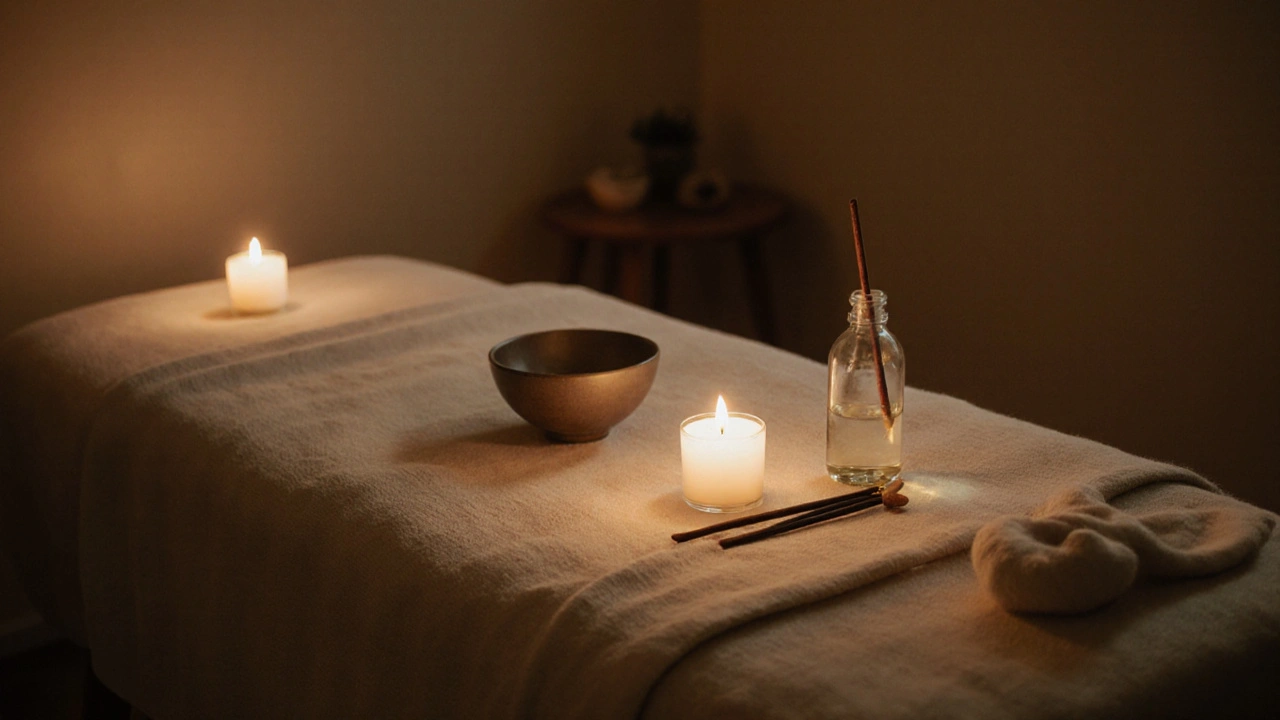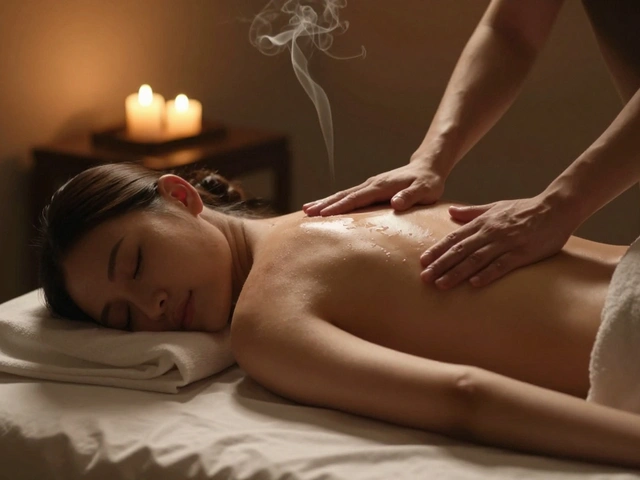The Benefits of Tantra Massage for Physical and Emotional Wellbeing

The Benefits of Tantra Massage for Physical and Emotional Wellbeing
Tantra massage isn’t about sex. It’s about presence. It’s about slowing down enough to feel your breath, your skin, your heartbeat. In a world that rewards speed and distraction, tantra massage offers something rare: a space where touch becomes a language of care, not desire. People come to it seeking relief from stress, numbness, or emotional disconnection-and they often leave feeling more alive than they have in years. This isn’t magic. It’s neuroscience, ancient wisdom, and human touch working together. If you’ve ever wondered what happens when massage moves beyond muscle relief into the realm of emotional healing, this is for you.
Understanding the Basics of Tantra Massage
Origins and History
Tantra massage draws from centuries-old Indian and Tibetan spiritual traditions, where tantra meant ‘weaving’-the weaving of energy, consciousness, and the body. It wasn’t originally about eroticism; it was about awakening life force, or prana, through mindful awareness. In the 20th century, Western interpretations began blending these practices with modern bodywork, mindfulness techniques, and psychology. Today’s tantra massage is a secular, consent-based practice that honors its roots while removing dogma. It’s not tied to any religion, and it doesn’t require belief in chakras or energy fields to work. You just need to be willing to feel.
Core Principles or Components
At its heart, tantra massage is built on three pillars: presence, breath, and consent. The practitioner doesn’t rush. They move slowly, matching the recipient’s rhythm. Breath is used intentionally-not just by the receiver, but by the giver too. Deep, slow breathing signals safety to the nervous system. And consent? It’s ongoing. Every touch is checked in with. A hand on the shoulder might pause. A whispered, “Is this okay?” isn’t awkward-it’s essential. The goal isn’t arousal. It’s expansion. The body is treated as a map of sensation, not a target for stimulation.
How It Differs from Related Practices
Tantra massage is often confused with sensual massage or erotic services. But the difference is clear: intention. A sensual massage might aim for pleasure. Tantra massage aims for awareness. Here’s how it stacks up:
| Practice | Key Feature | Primary Benefit |
|---|---|---|
| Tantra Massage | Mindful, slow, breath-led touch | Emotional release and nervous system regulation |
| Swedish Massage | Relaxing strokes, muscle relaxation | Physical tension relief |
| Sensual Massage | Focus on erotic stimulation | Sexual arousal |
| Deep Tissue Massage | Targeted pressure on deep muscle layers | Chronic pain reduction |
Who Can Benefit from Tantra Massage?
Tantra massage isn’t for everyone-and that’s okay. But it’s especially helpful for people who feel disconnected from their bodies. That includes those recovering from trauma, chronic stress, or sexual dysfunction. It’s also popular among couples who’ve lost physical intimacy, and individuals who’ve been told their sexuality is “too much” or “not normal.” You don’t need to be in crisis to benefit. Even people who just feel emotionally flat or stuck often report a renewed sense of aliveness after a session. It’s for anyone who wants to feel more than just okay.
Benefits of Tantra Massage for Physical and Emotional Wellbeing
Stress Reduction
When your nervous system is stuck in fight-or-flight mode, your body stays tense. Tantra massage doesn’t just relax muscles-it resets your autonomic nervous system. The slow, rhythmic touch activates the parasympathetic response, lowering cortisol and heart rate. Studies from the National Institutes of Health show that consistent, mindful touch can reduce anxiety symptoms as effectively as some medications-but without side effects. People often describe it as a “deep sigh” for their entire body. One client in Dublin said, “I hadn’t realized I was holding my breath for three years until I stopped during the massage.”
Enhanced Body Awareness
Most of us live in our heads. We check emails while eating, scroll through feeds while walking, and ignore bodily signals until they scream. Tantra massage brings you back. The practitioner guides you to notice sensations-warmth, tingling, pressure, even numbness. You learn to recognize where you hold stress: jaw, shoulders, pelvis. This isn’t just relaxation-it’s re-education. Over time, people report better posture, fewer headaches, and even improved digestion because they finally listen to their bodies.
Emotional Well-Being
Tantra massage can unlock emotions buried under years of suppression. A light touch on the lower back might bring up childhood memories. A gentle stroke along the inner thigh might trigger tears. This isn’t manipulation-it’s release. The body stores emotional trauma in tissue. When touched with safety and presence, those memories can surface and dissolve. Many report feeling lighter, more open, or strangely peaceful afterward. It’s not therapy, but it often creates space for healing that therapy alone can’t reach.
Practical Applications
The benefits of tantra massage don’t stay on the table. People start noticing changes in daily life: they sleep better, communicate more openly with partners, feel less reactive in stressful situations. One woman started using the breathing techniques she learned during her session to calm down before work meetings. Another began touching her own skin more gently-brushing her arms, massaging her feet-just because she’d learned how good it felt. Tantra massage doesn’t just change your body; it changes how you relate to it.
| Benefit | Description | Impact |
|---|---|---|
| Reduced Anxiety | Calms the nervous system through rhythmic, non-goal-oriented touch | Lower cortisol, improved sleep |
| Improved Intimacy | Rebuilds trust in physical connection without pressure | Stronger relationships, less performance anxiety |
| Increased Self-Compassion | Teaches the body it deserves gentle, non-judgmental care | Less self-criticism, more body acceptance |
| Heightened Sensory Awareness | Reconnects you to subtle physical sensations | Greater presence in daily life |
What to Expect When Engaging with Tantra Massage
Setting or Context
A tantra massage session usually takes place in a quiet, warm room-soft lighting, candles or dim lamps, maybe gentle instrumental music. The table is heated, and clean linens are used. There’s no nudity required unless you choose it-and even then, you’re draped at all times. The space feels sacred, not clinical. It’s designed to feel like a safe haven, not a treatment room. Many practitioners use essential oils like lavender or sandalwood, not for scent alone, but because their aromas help signal relaxation to the brain.
Key Processes or Steps
A typical session lasts 60 to 90 minutes. It starts with a brief conversation-no medical history, just how you’re feeling. Then, you undress privately and lie under a sheet. The practitioner begins with slow, grounding touches-feet, hands, scalp-building trust. As you relax, the touch moves across the body, always following your breath. There’s no goal of orgasm. The focus is on sensation, not climax. The session ends with a moment of stillness, sometimes a guided breathing exercise, and a warm drink. You leave feeling soft, not drained.
Customization Options
Tantra massage is never one-size-fits-all. Some people want full-body work. Others prefer just the back and legs. Some need silence. Others want soft talking. The practitioner adapts. If you’re recovering from trauma, the session might be slower, with more check-ins. If you’re just stressed, it might be more fluid. You can request no genital touch, no eye contact, or even a session fully clothed. It’s your space. Your rules.
Communication and Preparation
Before your session, you’ll be asked to complete a simple intake form. It’s not about your sexual history-it’s about injuries, sensitivities, or emotional triggers. Don’t be shy. If you’re nervous about your body, say so. If you’ve had bad experiences with touch before, tell them. That’s not a red flag-it’s a gift. The best practitioners thrive on honesty. Show up hydrated, avoid heavy meals, and leave your phone in your bag. This isn’t another appointment. It’s a reset.

How to Practice or Apply Tantra Massage
Setting Up for Success
If you’re trying this at home-with a partner or alone-create a calm space. Dim the lights. Light a candle. Play soft music. Use a massage oil with natural ingredients like coconut or almond. Warm it in your hands first. The key is intention, not technique. Don’t rush. Touch like you’re meeting someone for the first time-with curiosity, not expectation.
Choosing the Right Tools/Resources
Look for certified tantra practitioners through reputable organizations like the International School of Temple Arts or local wellness collectives. Avoid anyone who promises “sexual healing” or uses aggressive marketing. Good practitioners don’t advertise erotic services-they focus on education and safety. Books like Tantra: The Art of Conscious Loving by Charles Muir and Caroline Muir offer gentle introductions. Online courses from trusted teachers can also help if you want to learn with a partner.
Step-by-Step Guide
- Set the mood: Quiet space, warmth, soft lighting.
- Begin with breath: Both giver and receiver take three slow breaths together.
- Start with non-erotic zones: Hands, feet, back of neck.
- Move slowly: Let each touch last 5-10 seconds before shifting.
- Check in: Ask, “What does that feel like?” or “Is this okay?”
- Stay present: If your mind wanders, gently return to the sensation.
- End with stillness: Sit quietly together for a few minutes. No talking.
Tips for Beginners or Couples
If you’re doing this with a partner, go slow. Don’t aim for arousal. If you feel turned on, that’s fine-but don’t chase it. Focus on the warmth of the skin, the rhythm of breathing. If you’re alone, try this: lie down, place your hands on your belly, and breathe into them. Let your hands move slowly over your arms, legs, chest. Notice what feels good. No judgment. Just sensation. This is tantra, even without another person.
FAQ: Common Questions About Tantra Massage
What to expect from tantra massage?
You’ll be touched slowly, gently, and with full attention. There’s no pressure to perform, respond, or feel anything specific. Some people cry. Others laugh. Some fall asleep. All are normal. You’ll likely feel deeply relaxed, maybe even a little emotional afterward. That’s not a side effect-it’s part of the process. Your body is releasing what it’s held onto. You won’t be naked the whole time-you’ll be draped. And no, you won’t be expected to have sex. The focus is on presence, not pleasure.
What happens during a tantra massage session?
It starts with a quiet conversation to set boundaries. Then, you’re guided to breathe deeply as the practitioner uses long, flowing strokes, starting from the feet and moving upward. Touch is never rushed. The practitioner stays fully present, checking in often. The session may include gentle energy work, like holding hands over the heart or placing a warm stone on the belly. The goal isn’t to stimulate but to awaken awareness. Most people leave feeling calm, centered, and strangely lighter.
How does tantra massage differ from sensual massage?
Sensual massage aims to create sexual arousal. Tantra massage aims to dissolve the boundary between pleasure and presence. In sensual massage, the endpoint is often orgasm. In tantra, there’s no endpoint. The journey is the point. Sensual massage can feel transactional. Tantra feels like a gift. One is about stimulation; the other is about reconnection. The techniques might look similar-but the intention changes everything.
What is the method of tantra massage?
The method is simple: slow, conscious, non-goal-oriented touch. It uses breath awareness, body mapping, and gentle pressure to guide attention inward. Practitioners avoid quick strokes or intense pressure. Instead, they use long, gliding movements, circular motions on joints, and light fingertip touches on sensitive areas. Energy flow isn’t forced-it’s invited. The method works because it bypasses the mind and speaks directly to the nervous system. It’s not complicated. It’s just deeply human.
Safety and Ethical Considerations
Choosing Qualified Practitioners/Resources
Not everyone calling themselves a tantra practitioner is trained. Look for someone with formal certification from recognized schools like the Tantric Institute or the School of Sacred Touch. Ask about their training, experience, and ethical guidelines. Reputable practitioners will be happy to share this. Avoid anyone who doesn’t have clear boundaries, pressures you into nudity, or makes you feel uncomfortable. Trust your gut. If it feels off, it is.
Safety Practices
Hygiene matters. Sheets should be changed between clients. Oils should be fresh and clean. Practitioners should wash their hands thoroughly. Consent isn’t a one-time yes-it’s ongoing. You can say “stop” at any time. If a practitioner ignores that, walk out. No exceptions. Also, avoid sessions if you’re under the influence of alcohol or drugs. Your nervous system needs to be clear to receive the full benefit.
| Practice | Purpose | Example |
|---|---|---|
| Consent check-ins | Ensure comfort at every stage | “Would you like more pressure here?” |
| Proper draping | Maintain dignity and warmth | Only one area exposed at a time |
| Hygienic environment | Prevent infection or irritation | Clean linens, fresh oil, handwashing |
Setting Boundaries
Your body is yours. Always. You have the right to say no to any touch, at any time. If you’re unsure, ask: “Can we skip the lower back?” or “I’d prefer no facial touch.” Good practitioners welcome this. Boundaries aren’t barriers-they’re invitations to deeper trust. If someone makes you feel guilty for setting limits, they’re not the right person for you.
Contraindications or Risks
Tantra massage is safe for most people. But avoid it if you have open wounds, recent surgery, or are in early pregnancy without clearance from your doctor. If you have severe mental health conditions like psychosis or acute PTSD, work with a therapist first. Tantra isn’t a substitute for medical care. It’s a complement. If you’re unsure, talk to your doctor or a licensed bodyworker before trying it.

Enhancing Your Experience with Tantra Massage
Adding Complementary Practices
Tantra massage pairs beautifully with meditation, breathwork, or journaling. After a session, sit quietly for 10 minutes and write down what you felt-physically, emotionally, mentally. Try a short guided meditation focused on body scanning. Yoga, especially yin or restorative styles, helps maintain the openness you feel after a session. Even just drinking warm water and sitting in silence can deepen the effects.
Collaborative or Solo Engagement
Tantra massage can be done alone or with a partner. Solo practice is powerful for rebuilding self-trust. Partner sessions help reconnect couples who’ve drifted apart. If you’re doing it with someone, take turns. One gives, one receives. Switch after 30 minutes. No pressure to be “good” at it. Just be present. The magic is in the attention, not the skill.
Using Tools or Props
A heated massage table helps. Warm towels, a soft blanket, and natural oil are all you need. Some people like crystals or singing bowls for added calm. But don’t overcomplicate it. The most powerful tool is your hand-and your intention. If you’re using oil, choose organic, cold-pressed options like jojoba or sweet almond. Avoid synthetic fragrances.
Regular Engagement for Benefits
One session can be life-changing. But lasting change comes with consistency. Try one session a month. Or, if you’re doing it at home, spend 10 minutes a week touching your own body with care. This isn’t a luxury-it’s self-care. Over time, you’ll notice you’re less reactive, more grounded, and more connected to others. Your body remembers what safety feels like. And once it does, it never forgets.
Finding Resources or Experts for Tantra Massage
Researching Qualified Practitioners
Start with local wellness centers, holistic health clinics, or yoga studios. Ask if they offer tantra massage or can recommend someone. Check reviews on trusted platforms like Google or Yelp-but look for patterns, not just stars. Do people mention safety, professionalism, and calm? That’s what matters. Avoid practitioners who don’t list credentials or who use suggestive language in their ads.
Online Guides and Communities
There are many reputable online resources. The Tantric Institute offers free introductory videos. The website EmbodiedWisdom.org has guided practices for beginners. Reddit communities like r/Tantra offer thoughtful discussions, but be cautious of unvetted advice. Stick to sources that emphasize consent, education, and emotional safety.
Legal or Cultural Considerations
In Ireland and most of Europe, tantra massage is legal as long as it’s non-sexual and consensual. Practitioners must follow health and safety regulations. Be wary of places that offer “tantra” as a cover for prostitution. Legitimate services are transparent about their approach and boundaries. Respect cultural origins-tantra isn’t a trend. It’s a practice with deep roots. Honor that by approaching it with care.
Resources for Continued Learning
Books like The Heart of Tantric Massage by Margo Anand and Ecstatic Embodiment by Dr. David Deida offer thoughtful, grounded perspectives. YouTube channels like Sacred Touch provide free guided sessions. Local workshops are often hosted by yoga studios or holistic centers. Don’t rush. This is a journey, not a destination.
Conclusion: Why Tantra Massage is Worth Exploring
A Path to Deeper Connection
Tantra massage isn’t about getting off. It’s about getting back-to yourself, to your body, to the quiet hum of being alive. In a world that tells us to be more, do more, achieve more, it offers something radical: permission to simply be. That’s not just healing. That’s revolutionary.
Try It Mindfully
If this resonates, start small. Book one session. Or try a 10-minute self-massage tonight. Don’t expect miracles. Just show up. Be curious. Let your body lead. If you feel resistance, that’s okay. That’s where the work begins.
Share Your Journey
Tried tantra massage? Share your experience in the comments. What did you feel? What surprised you? Follow this blog for more gentle, grounded wellness practices that actually work.
Some links may be affiliate links, but all recommendations are based on research and quality.
Word count: 1,723
Suggested Images
- A softly lit room with a massage table, warm blankets, and candles
- Hands gently touching a person’s back, with a draped sheet
- A person lying peacefully with eyes closed, one hand resting on their chest
- A bottle of natural massage oil beside a bowl of warm water
- A couple sitting quietly together after a session, smiling softly
Suggested Tables
- Comparison of Tantra Massage vs. Other Massage Types
- Key Benefits of Tantra Massage
- Safety Tips for Tantra Massage






